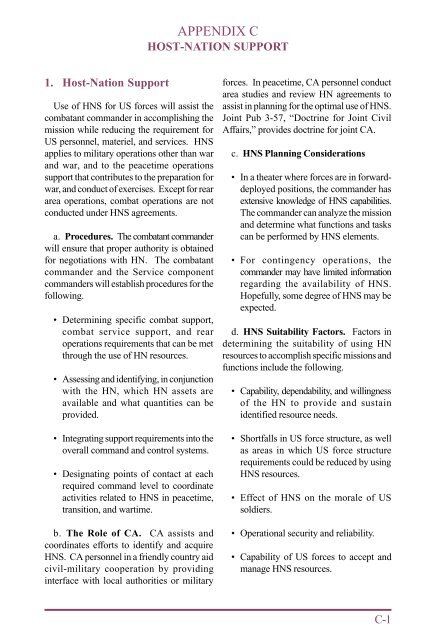JP 4-01.5 JTTP for Water Terminal Operations - BITS
JP 4-01.5 JTTP for Water Terminal Operations - BITS
JP 4-01.5 JTTP for Water Terminal Operations - BITS
You also want an ePaper? Increase the reach of your titles
YUMPU automatically turns print PDFs into web optimized ePapers that Google loves.
1. Host-Nation Support<br />
Use of HNS <strong>for</strong> US <strong>for</strong>ces will assist the<br />
combatant commander in accomplishing the<br />
mission while reducing the requirement <strong>for</strong><br />
US personnel, materiel, and services. HNS<br />
applies to military operations other than war<br />
and war, and to the peacetime operations<br />
support that contributes to the preparation <strong>for</strong><br />
war, and conduct of exercises. Except <strong>for</strong> rear<br />
area operations, combat operations are not<br />
conducted under HNS agreements.<br />
a. Procedures. The combatant commander<br />
will ensure that proper authority is obtained<br />
<strong>for</strong> negotiations with HN. The combatant<br />
commander and the Service component<br />
commanders will establish procedures <strong>for</strong> the<br />
following.<br />
• Determining specific combat support,<br />
combat service support, and rear<br />
operations requirements that can be met<br />
through the use of HN resources.<br />
• Assessing and identifying, in conjunction<br />
with the HN, which HN assets are<br />
available and what quantities can be<br />
provided.<br />
• Integrating support requirements into the<br />
overall command and control systems.<br />
• Designating points of contact at each<br />
required command level to coordinate<br />
activities related to HNS in peacetime,<br />
transition, and wartime.<br />
b. The Role of CA. CA assists and<br />
coordinates ef<strong>for</strong>ts to identify and acquire<br />
HNS. CA personnel in a friendly country aid<br />
civil-military cooperation by providing<br />
interface with local authorities or military<br />
APPENDIX C<br />
HOST-NATION SUPPORT<br />
<strong>for</strong>ces. In peacetime, CA personnel conduct<br />
area studies and review HN agreements to<br />
assist in planning <strong>for</strong> the optimal use of HNS.<br />
Joint Pub 3-57, “Doctrine <strong>for</strong> Joint Civil<br />
Affairs,” provides doctrine <strong>for</strong> joint CA.<br />
c. HNS Planning Considerations<br />
• In a theater where <strong>for</strong>ces are in <strong>for</strong>warddeployed<br />
positions, the commander has<br />
extensive knowledge of HNS capabilities.<br />
The commander can analyze the mission<br />
and determine what functions and tasks<br />
can be per<strong>for</strong>med by HNS elements.<br />
• For contingency operations, the<br />
commander may have limited in<strong>for</strong>mation<br />
regarding the availability of HNS.<br />
Hopefully, some degree of HNS may be<br />
expected.<br />
d. HNS Suitability Factors. Factors in<br />
determining the suitability of using HN<br />
resources to accomplish specific missions and<br />
functions include the following.<br />
• Capability, dependability, and willingness<br />
of the HN to provide and sustain<br />
identified resource needs.<br />
• Shortfalls in US <strong>for</strong>ce structure, as well<br />
as areas in which US <strong>for</strong>ce structure<br />
requirements could be reduced by using<br />
HNS resources.<br />
• Effect of HNS on the morale of US<br />
soldiers.<br />
• Operational security and reliability.<br />
• Capability of US <strong>for</strong>ces to accept and<br />
manage HNS resources.<br />
C-1
















